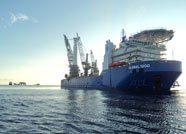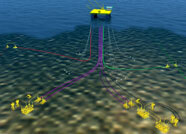Details that Define Success
The Who Dat oil and gas project, located in the Gulf of Mexico's Mississippi Canyon area, holds 100-300M barrels of oil equivalent, with a 30-year life. Operated by LLOG Exploration, it began production in December 2011, utilizing an Opti-Ex FPS semi-submersible on demand facility. With a focus on safety, efficiency, and efficient production operations, Who Dat represents a significant contribution to the US offshore oil and gas industry.
- Client: LLOG
- Location: Mississippi Canyon 547 “A”
- Water depth: 3,100'
- Overview: New FPU, 10K rated, 7 ea 6" Infield Flowlines, 5 ea Infield Umbilicals, 14" Oil Export and 10" Gas Export pipelines
- Gas throughput capacity: 150,000 MMcf/d
- Oil throughput capacity: 60,000 BOPD
- Flowline size: 6"
- Length: ~15,000 to 18,000'
Rick Fowler said that the “flexible” design of the OPTI-Ex facility allowed LLOG to accelerate field development. It was less than one year between the selection of the facility to field development.
Offshore Magazine, Oct. 12, 2011
Performance Metrics Speak Volumes Beyond Numbers
At the core of our success lies a powerful combination: practicality and safety.
Schedule
Initial production for Who Dat was achieved in approximately 14 months from FID.
Productivity
The facility was designed for a processing capability of 60,000 barrels of oil per day.
Efficiency and Safety
We prioritize safety alongside engineering and project management best practices, optimizing schedules and budgets.
Awarded Offshore Magazine Top 5 Project 2011
A testament to dedication and collaboration, Who Dat receives many offshore "firsts." Offshore Magazine recognized the Who Dat development for:
Notable achievements for the field development include the first use of the OPTI-EX design; the first use of an FPU built “on spec;” and the first use of a privately owned FPU.
Who Dat Continues to Make Waves
Explore Who Dat's groundbreaking achievements and safety milestones in deepwater exploration. From industry publications to mainstream news, discover its innovative practices, substantial output, time-saving efficiencies, and safety measures.




